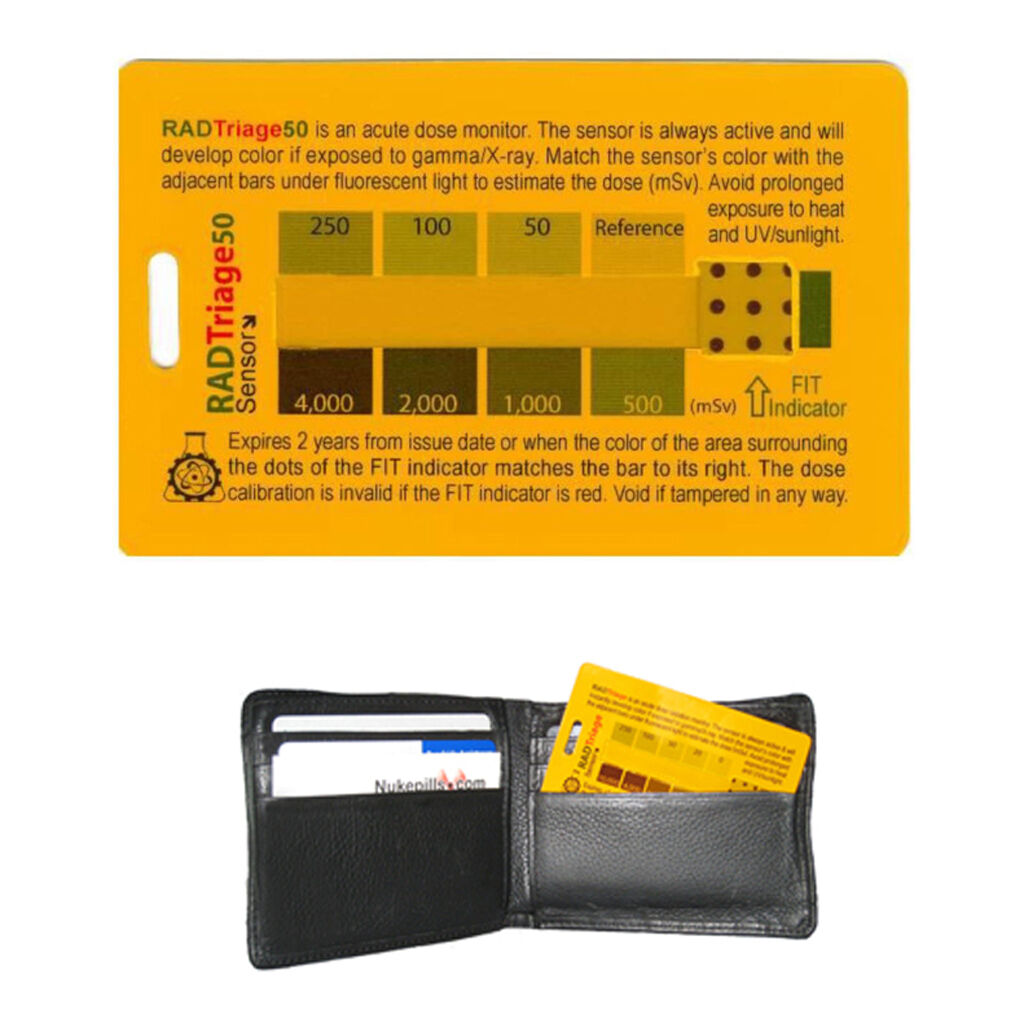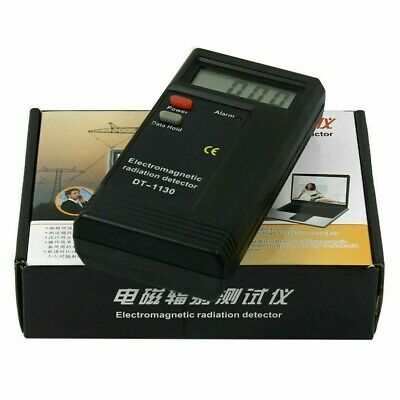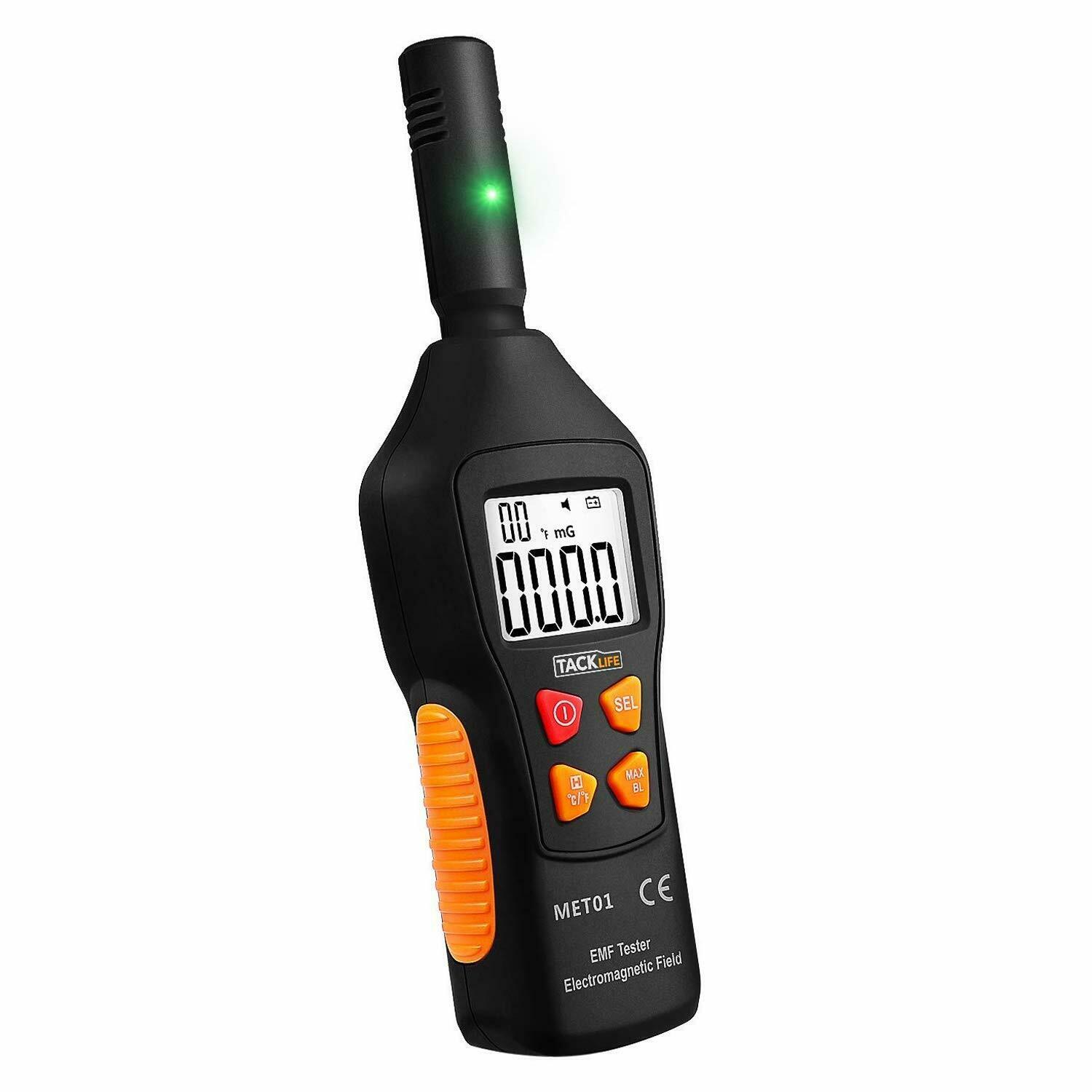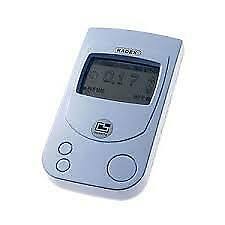-40%
RADTriage 50 Personal Radiation Detector for wallet or pocket. FREE SHIPPING.
$ 10.53
- Description
- Size Guide
Description
The RADTriage 50 Radiation Detectoris a U.S. Military-grade personal dosimeter that
instantly
detects radiation exposure in the event of a dirty bomb, nuclear reactor accident and other sources of radiation such as Fukushima. This always-on wallet card/badge radiation detector does not require batteries or calibration. The sensor strip instantly turns darker when it detects harmful levels of radiation. .
Credit card size: 3 3/8″ x 2 1/8 ″ This listing is for one card. Just one. Not 50. Just one. "50" is the model number. Think Boeing 757. Or iPhone 7. Just one. One. ONE.
Service life of at least 2 years at room temperature. Can be frozen for at least 10 years to extend shelf like.
Instant detection of radiation from sources such as nuclear reactors (Fukushima) and dirty bombs
No batteries or calibration needed
Impervious to an EMP Bomb (electromagnetic pulse)
Field tested and approved by Dept of Homeland Security
U.S. Military grade
Made in the U.S.A
Fits wallet or badge holder
Will instantly detect radiation while stored in wallet, badge holder, pocket, etc.
DHS Test Report Findings
From the Department of Homeland Security (DHS) Final Test Report on the RADTriage (SIRAD):
- RADTriage was found to demonstrate
“acceptable performance for homeland security mission needs. If routinely carried by emergency responders, it could provide early indication of a significant radiation component after a terrorist event”.
- "The SIRAD [RADTriage] demonstrated generally acceptable performance for homeland security mission needs. Incidence of loss or damage to the device during field deployment was low, false positive rates were less than one percent, and field conditions and physical stresses did not seem to compromise performance."
Objective of the RADTriage
The RADTriage, a stockpileable personal radiation detector, provides wearers, medical personnel and law enforcement personnel timely personal radiation exposure information in an event of a terrorist radiological incident or industrial accident. RADTriage, with the amber laminated filter, provides significantly longer life in direct sunlight. The
RADTriage,
part of the
SIRAD
(
S
elf-
I
ndicating
R
adiation
A
lert
D
osimeter) family of SMART dosimeters, is uniquely designed to prevent erroneous readings. It has a sensor (a rectangular strip between the color bars) with 0 (reference), 50, 100 & 250 mSv bars on its top and 500, 1000, 2000 and 4000 mSv bars on its bottom for triaging information in emergencies. If, during or after the incident, the color of sensor has not changed, the wearer has not received radiation exposure large enough to cause acute medical effects and therefore has peace of mind. If the sensor changes color, radiation exposure is indicated. In this case, further exposure should be avoided. The RADTriage does not reset itself after exposure to radiation and should at that time be replaced. If the Sensor has developed a darker color, e.g., above 250 mSv, the user should seek a medical evaluation. A person exposed to a dose higher than 500 mSv should immediately contact the emergency room of the nearest hospital.
Introduction
The RADTriage (USP# 7,227,158 and others) is always active and ready to use. It is a smart dosimeter and has the capability of monitoring shelf life, false positives/negatives and tampering. When exposed to radiation, e.g., from a “dirty bomb”, the sensor of the RADTriage changes color instantly. The color changes are permanent, cumulative and proportional to dose, thereby providing the wearer and medical personnel instantaneous, easy to read information on radiation exposure of the wearer to assess the health risks and guide medical treatment. The RADTriage does not reset itself after exposure to radiation and should at that time be replaced.
Types of Radiation
The RADTriage sensor responds to gamma/X-ray (energy higher than 30 KeV) and high energy (e.g., above 1 MeV) electrons/beta particles. Color development of the Sensor is essentially independent of dose rate. However, protective films attenuate low energy (below 200 KeV) X-ray. RADTriage will not be affected by normal exposures to diagnostic X-rays (e.g., chest or dental) or security/airport X-ray/CAT scan machines, except that multiple exposures (more than five) to such will result in sufficient enough exposure to produce a detectable color change in the sensor.
How to Read Dose with RADTriage
Estimate the exposure dose by comparing the color of the sensor with the Sensor Reference Bars. Find a bar which closely matches the color of the sensor and read the dose in mSv printed adjacent to those bars. If the Sensor develops a color in-between any two adjacent bars, this indicates an in-between dose. For a nearly tissue equivalent dosimeter, such as RADTriage, 1 rad = 1 rem = 10 mSv. It can be viewed in any light. However, we recommend reading the dose under fluorescent lights for better accuracy. Color matching under other lights may not be as accurate. Dose can be estimated with an uncertainty of about 20% with a color-matching reference chart. Where additional accuracy is needed, a spectrophotometer or an optical densitometer can be used to determine the dose to within 10%. The RADTriage does not reset itself after exposure to radiation and should at that time be replaced.
Effects of Heat and UV Light
The sensor of the RADTriage will develop colors faster if exposed to UV/sunlight for a prolonged period. Keep the RADTriage at or below normal room temperature. Repeated, e.g., hundreds, of readings where the sensor gets exposed for less than a minute per reading (even under direct sunlight) will cause little or no color development in the sensor.
False Positive and Tamper Indicators
If used as per instructions, it is unlikely that the RADTriage will provide false positives or false negatives. Your RADTriage is a SMART personal dosimeter, equipped with a simple-to-use revolutionary indicator for monitoring the deliberate or inadvertent exposure to high temperatures or ultraviolet light. We call it the FITIndicator (
F
alse-positive,
I
nactivation and
T
amper) and it is located on the right hand end of the sensor. The FIT Indicator simultaneously monitors false positives & negatives, overexposure to heat & UV/ sunlight, shelf-life, inactivation and/or altered sensitivity.
Inactivation & False Negative Indicator:
If the dots of the FIT Indicator is dark blue, the sensor is active, it is monitoring radiation and the calibration is valid. However, if it has changed to red, your RADTriage has been heated near or above 175
o
F/80
o
C which has made the sensor inactive to radiation or of altered sensitivity to radiation. DO NOT USE the dosimeter if the dots of the FIT Indicator are red. Turn the dosimeter in to the issuing organization with a description of the circumstances. The heat treatment can be used by medical authorities to fix the sensor for permanently documenting the radiation exposure as a part of a medical record. Medical personnel requiring this capability should contact the distributor, Nukepills.com.
False Positive Indicator:
The shelf life (expiration date) of the dosimeter is based on storage of the RADTriage at room temperature (77
o
F/25
o
C) or below and continuous protection from ultraviolet/sunlight exposures. Shelf life will be reduced if it is stored at higher temperatures and/or exposed to UV/sunlight for a prolonged period (e.g., more than a few hours of direct sunlight). The area surrounding the dots should be lighter in color when issued/purchased. If it has developed a color matching or darker than the Color Reference Bar on its right, the shelf-life of the RADTriage has expired; it was overexposed to UV light, and/or exposed to higher temperatures for a prolonged period. The sensitivity of the FIT Indicator to X-rays is hundreds of times lower than that of the sensor.
Shelf-Life
The sensor of the RADTriage will develop color equivalent to about 10 mSv in about two years if stored at 77
o
F/25
o
C. The shelf-life/guaranty of the RADTriage expires two years from the issue date and definitely when the color of the area
surrounding
the dots of the FIT Indicator is
darker
than the Vertical Reference Bar to its right-hand side. It doesn't matter if the dots themselves are as dark - they are supposed to be. The dots just shouldn't change to purple or red.
The shelf-life of the RADTriage50 can be extended up to 10 years by storing in the freezer. Once removed it will have a usable life of at least two years.
UV/Tamper Detector
A small portion of the sensor is covered with the FIT Indicator. The substrate of the FIT Indicator is 100% opaque to visible and UV light but transparent to X-rays and gamma-rays. If the color development of the sensor is due to exposure to high energy ionizing radiation, the whole sensor will be uniformly colored. If the color development of the sensor is due to exposure to UV light, the color of the sensor under the FIT Indicator will be lighter. If you suspect the color development of the sensor is due to exposure to high energy ionizing radiation, return the RADTriage to Nukepills.com. For a fee, we will remove the sensor for determination of genuine exposure or false positive.
Reporting Exposure
If the sensor of the RADTriage develops darker color and the color development is not due to prolonged exposure to high temperatures, UV/sunlight, and/or expiration of shelf life, estimate the dose and immediately report it to the department/agency/organization issuing the dosimeter. Seek advice and medical help immediately from your agency/company medical office, your personal health care provider or county public health office, especially if the dose is higher than 250 mSv. For a dose higher than 500 mSv, report to the nearest Emergency Room.














